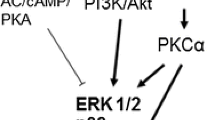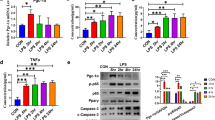Abstract
Treatment of neonatal rat cardiomyocytes for 72 h in the presence of tumor necrosis factor α (TNFα) (10 U/ml) lead to a decrease in basal and α1-adrenoceptor-induced formation of the calcium-mobilizing second messenger inositol trisphosphate (IP3) and its metabolites, IP2 and IP1, by 35 and 26%, respectively. The synthesis of phosphatidylinositol bisphosphate (PIP2), the substrate of PI-specific phospholipase C, was decreased by 45% following the TNFα (10 U/ml) exposure. Time courses of TNFα (10 U/ml)-induced alterations in rat cardiomyocytes showed a parallel decline of basal inositol phosphate formation and PIP2 synthesis suggesting that the decrease in inositol phosphate formation was due to the reduction in PIP2 synthesis. As the TNFα-induced decrease of PIP2 synthesis was associated with a decreased synthesis of the phospholipid phosphatidylinositol (PI), the precursor of PIP2, by 33%, the decreased availability of PIP2 is apparently, at least in part, the result of the decreased synthesis of PI. As an apparent functional consequence of the decrease in IP3 formation following the TNFα exposure, the α1-adrenoceptor-mediated induction of arrhythmias by 100 μmol/l noradrenaline + 10 μmol/l timolol was abolished in TNFα-pretreated rat cardiomyocytes.
To investigate one of the possible mechanisms of the TNFα-induced decrease of PIP2 formation, the effect of TNFα pretreatment on glycerol-3-phosphate dehydrogenase (GDH), a key enzyme of lipogenesis, was studied: Exposure of the rat cardiomyocytes for 72 h to TNFα induced a concentration-dependent decrease in GDH activity by maximally 55%.
The result presented are consistent with the hypothesis that the decreased basal and α1-adrenoceptor-induced formation of the second messenger IP3 observed in chronic endotoxinemia and sepsis may be mediated by a TNFα-induced decrease in the synthesis of PIP2, the substrate of PI-specific phospholipase C. This mechanism occurs following long-term exposure to low TNF/ha concentrations and is apparently distinct from the short-term cardiac effects induced by high concentrations of TNFα.
Similar content being viewed by others
References
Bergmeyer HU, Graßl M, Walter HE (1983) Samples, reagents, assessment of results. In: Bergmeyer HU (ed) Methods of enzymatic analysis, vol II, 3rd ed. Verlag Chemie, Weinheim, Deefield Beach USA, Basel, pp 215–216
Berridge MJ, Downes CP, Hanley MR (1982) Lithium amplifies agonist-dependent phosphatidylinositol responses in brain and salivary glands. Biochem J 206:587–595
Berridge MJ, Dawson RMC, Downes CP, Heslop JP, Irvine RF (1983) Changes in the levels of inositol phosphates after agonist-dependent hydrolysis of membrane phosphoinositides. Biochem J 212:473–482
Carcillo JA, Litten RZ, Suba EA, Roth BL (1988) Alterations in rat aortic alpha1-adrenergic stimulated phosphoinositide hydrolysis in intraperitoneal sepsis. Circ Shock 26:331–339
Chernow B, Rainey TO, Lake CR (1982) Endogenous and exogenous catecholamines in critical care medicine. Crit Care Med 10:409–416
Creba JA, Downes CP, Hawkins PT, Brewster G, Michell RH, Kirk CJ (1983) Rapid breakdown of phosphatidylinositol 4-phosphate and phosphatidylinositol 4,5-bisphosphate in rat hepatocytes stimulated by vasopressin and other Ca2+-mobilizing hormones. Biochem J 212:733–747
Finkel MS, Oddis CV, Jacob TD, Watkins SC, Hattler BG, Simmons RL (1992) Negative inotropic effects of cytokines on the heart mediated by nitric oxide. Science 257:387–389
Fleming I, Julou-Schaeffer G, Gray GA, Parratt JR, Stoclet JC (1991) Evidence that an l-arginine/nitric oxide dependent elevation of tissue cyclic GMP content is involved in depression of vascular reactivity by endotoxin. Br J Pharmacol 103:1047–1052
Gray GA, Schott C, Julou-Schaeffer G, Fleming I, Parratt JR, Stoclet JC (1991) The effect of inhibitors of the l-arginine/nitric oxide pathway on endotoxin-induced loss of vascular hyporeactivity in anaesthetized rats. Br J Pharmacol 103:1218–1224
Gulick T, Chung MK, Pieper SJ, Lange LG, Schreiner OF (1989) Interleukin 1 and tumor necrosis factor inhibit cardiac myocyte ß-adrenergic responsiveness. Proc Natl Acad Sci USA 86:6753–6757
Hayward S, Cox S, Mitchell I, Hallowes N, Deshpande N, Towler J (1987) The effects of interferons on the activity of α-glycerophosphate dehydrogenase in benign prostatic hyperplasia cells in primary culture. J Urol 138:648–653
Hollenberg SM, Cunnion RE, Parrillo JE (1991) The effect of tumor necrosis factor on vascular smooth muscle. In vitro studies using rat aortic rings. Chest 100:1133–1137
Jones SB, Romano FD (1990) Myocardial beta adrenergic receptor coupling to adenylate cyclase during developing septic shock. Circ Shock 30:51–61
Julou-Schaeffer G, Gray GA, Fleming I, Schott C, Parratt JR, Stoclet JC (1990) Loss of vascular responsiveness induced by endotoxin involves the L-arginine pathway. Am J Physiol 259:H1038-H1043
Kaku T, Lakatta E, Filburn C (1991) α-Adrenergic regulation of phosphoinositide metabolism and protein kinase C in isolated cardiac myocytes. Am J Physiol 260 (Cell Physiol 29) C635-C642
Lowry OH, Rosebrough NJ, Farr AL, Randall RJ (1951) Protein measurement with the Folin reagent. J Biol Chem 193:265–275
McGinnis JF, DeVellis J (1978) Glucocorticoid regulation in rat brain cell cultures. J Biol Chem 253:8483–8492
McKenna TM (1990) Prolonged exposure of rat aorta to low levels of endotoxin in vitro results in impaired contractility. Association with vascular cytokine release. J Clin Invest 86:160–168
McMillan M, Chernow B, Roth BL (1986) Hepatic alpha1-adrenergic receptor alteration in a rat model of chronic sepsis. Circ Shock 19:185–193
Reithmann C, Werdan K (1989) Noradrenaline-induced desensitization in cultured heart cells as a model for the defects of the adenylate cyclase system in severe heart failure. Naunyn-Schmiedebergs Arch Pharmacol 339:138–144
Reithmann C, Gierschik P, Werdan K, Jakobs KH (1991) Tumor necrosis factor α up-regulates Giα and Gß proteins and adenylyl cyclase responsiveness in rat cardiomyocytes. Eur J Pharmacol (Mol Pharm Section) 206:53–60
Rodriguez de Turco EB, Spitzer JA (1987) Impairments in hepatocyte phosphoinositide metabolism in endotoxinemia. Metabolism 36:753–760
Rosenbaum JS, Azhar S, Hoffman BB (1987) Alpha1 adrenergic receptor mediated phosphoinositide breakdown in DDT1-MF2 cells. Lack of evidence of desensitization after prolonged exposure to epinephrine. Biochem Pharmacol 36:4335–4340
Scholz J (1989) Inositoltrisphosphat, ein neuer “Second Messenger” für positiv inotrope Wirkungen am Herzen? Klin Wochenschr 67:271–279
Scholz J, Schaefer B, Schmitz W, Scholz H, Steinfath M, Lohse M, Schwabe U, Puurunen J (1988) Alpha-1 adrenoceptor-mediated positive inotropic effect and inositol trisphosphate increase in mammalian heart. J Pharm Exp Ther 245:327–335
Steinberg SF, Kaplan LM, Inouye T, Zhang JF, Robinson RB (1989) Alpha-1 adrenergic stimulation of 1,4,5-inositol trisphosphate formation in ventricular myocytes. J Pharm Exp Ther 250:1141–1148
Stuehr DJ, Cho HS, Kwon NS, Weise MT, Nathan CF (1991) Purification and characterization of the cytokine-induced macrophage nitric oxide synthase: An FAD- and FMN-containing flavoprotein. Proc Natl Acad Sci USA 88:7773–7777
Suba EA, McKenna TM, Williams TJ (1992) In vivo and in vitro effects of endotoxin on vascular responsiveness to norepinephrine and signal transduction in the rat. Circ Shock 36:127–133
Torti FM, Dieckmann B, Bender B, Cerami A, Ringold GM (1985) A macrophage factor inhibits adipocyte gene expression: an in vitro model of cachexia. Science 229:867–869
Vicaut E, Hou X, Pagen D, Bousseau A, Tedgui A (1991) Acute effects of tumor necrosis factor on the microcirculation in rat cremaster muscle. J Clin Invest 87:1537–1540
Wakabayashi I, Hatake K, Kakishita E, Nagai K (1987) Diminution of contractile response of the aorta from endotoxin-injected rats. Eur J Pharmacol 141:117–122
Wakabayashi I, Hatake K, Sakamoto K (1991) Mechanisms of ex vivo aortic hypocontractility in endotoxemic rat. Eur J Pharmacol 199:115–118
Werdan K, Erdmann E (1989) Preparation and culture of embryonic and neonatal heart muscle cells: modification of transport activity. Methods Enzymol 173:634–662
Wykle RL (1977) Brain. In: Syngden F (ed) Lipid metabolism in mammals, vol 1. Plenum Press, New York, pp 317–366
Author information
Authors and Affiliations
Additional information
Correspondence to: C. Reithmann at the above address
Rights and permissions
About this article
Cite this article
Reithmann, C., Werdan, K. Tumor necrosis factor α decreases inositol phosphate formation and phosphatidylinositol-bisphosphate (PIP2) synthesis in rat cardiomyocytes. Naunyn-Schmiedeberg's Arch Pharmacol 349, 175–182 (1994). https://doi.org/10.1007/BF00169834
Received:
Accepted:
Issue Date:
DOI: https://doi.org/10.1007/BF00169834




